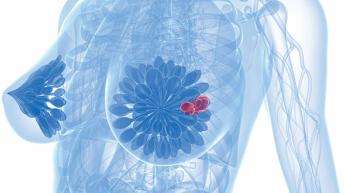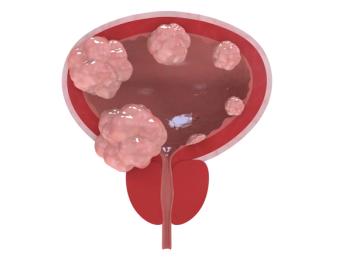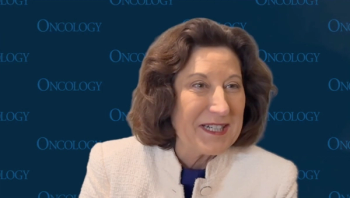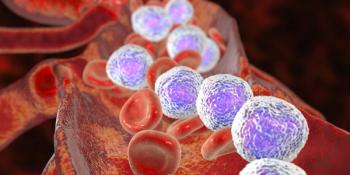
Bone Marrow Test Reveals Improved Survival in NPM1 and FLT3-Mutated AML
This study conducted within the phase 3 AML17 and AML19 trials revealed an OS rate of 69% in patients monitored for MRD and 58% in those not monitored.
A highly sensitive bone marrow test demonstrated that repeated molecular testing in patients with acute myeloid leukemia (AML) harboring mutations in the NPM1 and FLT3 genes led to improved survival rates compared with standard of care, according to findings from a joint analysis study published in The Lancet Haematology.1
The joint analysis focused on the phase 3 UK NCRI AML17 (ISRCTN55675535) trial and the phase 3 AML19 trial (ISRCTN78449203).
In a prespecified subgroup analysis of patients with both NPM1 and FLT3 internal tandem duplication (FLT3-ITD) mutations, the overall survival (OS) rate at 3 years was 69% (95% CI, 60%-79%) in the group with sequential molecular measurable residual disease (MRD) monitoring and 58% (95% CI, 45%-74%) in the group with standard clinical care that was not monitored (HR, 0.53; 95% CI, 0.31-0.91; P = .021). The study authors noted that there was significant heterogeneity between this subgroup and all other patients.
No difference in survival by randomization was observed in patients with NPM1 mutations who don’t have FLT3-ITD mutations, as the OS rate was 69% (95% CI, 62%-77%) in the monitored group and 78% (95% CI, 70%-87%) in the non-monitored group (HR, 1.56; 95% CI, 0.96-2.52); no difference was observed in patients with gene transcripts either, as the OS rate was 72% (95% CI, 65%-79%) in the monitored group and 77% (95% CI, 68%-87%) in the non-monitored group (HR, 1.28; 95% CI, 0.80-2.18).
In the overall analysis, with a median follow-up of 4.9 years (IQR, 3.6-5.9), the OS rate at 3 years was 70% (95% CI, 66%-75%) in the monitored group and 73% (95% CI, 68%-80%) in the non-monitored group; a meta-analysis showed there was no difference in OS (HR, 1.11; 95% CI, 0.83-1.49; P = .25).
“[AML] is the most aggressive form of blood cancer, so knowing early that a patient’s cancer is going to relapse is crucial for planning their treatment,” stated Richard Dillon, FRCPath, senior author and clinical senior lecturer in Cancer Genetics at King’s College London, in a press release.2 “We hope that these tests become part of routine care for this type of cancer across the UK and worldwide, and ultimately improve long-term survival rates for patients.”
A total of 637 patients were randomly assigned to be monitored or not monitored across both trials; the AML17 trial had 289 patients monitored and 144 non-monitored, and the AML19 trial had 136 patients monitored and 68 not monitored. An NMP1 mutation with FLT3-ITDmutation was observed in 140 patients; 94 of whom were monitored and 46 were not.
This was a study performed within 2 larger, randomized phase 3 trials. Patients were younger adults, generally 16 years to 60 years old, with newly diagnosed AML and a WHO performance status from 0 to 2 who were suitable for intensive chemotherapy.
The study treatment consisted of G-banded karyotype and fluorescence in-situ hybridization performed according to local protocols with peripheral blood or bone marrow samples obtained before treatment began. All patients with a confirmed fusion gene were eligible for random assignment, and patients were randomly assigned to receive different cytarabine-based and anthracycline-based induction and consolidation regimens.
Patients were deemed high-risk if they had an adverse karyotype by Medical Research Council criteria or a validated risk score higher than 2.667, among other reasons. All high-risk patients were designated for allogenic hematopoietic stem cell transplantation in first complete remission.
The primary trial end point was OS, and a prespecified subgroup objective of the primary end point was further analysis by molecular group. Secondary end points were relapse-free survival time, cumulative incidence of relapse, and cumulative incidence of death in complete remission.
Additionally, the trial observed a significant reduction in the cumulative incidence of relapse in the monitoring group (HR, 0.66; 95% CI, 0.49-0.88) and a significant improvement in relapse-free survival time (HR, 0.78; 95% CI, 0.61-0.99). No difference in the cumulative incidence of death in complete remission was observed between groups.
Jane Leahy, a 51-year-old patient from Wimbledon who took part in the trial, said in the press release, “[AML] is a horrific disease. Being enrolled on this trial saved my life and enabled doctors to try alternative treatments. It’s amazing to see great progress being made in improving treatment options for patients. I hope that being part of this research is going to help save the lives of so many others who are in a similar position to me.”2
References
- Potter N, Jovanovic J, Ivey A, et al. Molecular monitoring versus standard clinical care in younger adults with acute myeloid leukaemia: results from the UK NCRI AML17 and AML19 randomised, controlled, phase 3 trials. Lancet Haematol. 2025;12(5):E346-356. doi:10.1016/S2352-3026(25)00037-7
- Long-term survival rates of some acute myeloid leukaemia patients could double with sensitive bone marrow test. News release. King’s College London. April 28, 2025. Accessed April 30, 2025. https://tinyurl.com/2kk37s4e
Newsletter
Stay up to date on recent advances in the multidisciplinary approach to cancer.
















































































